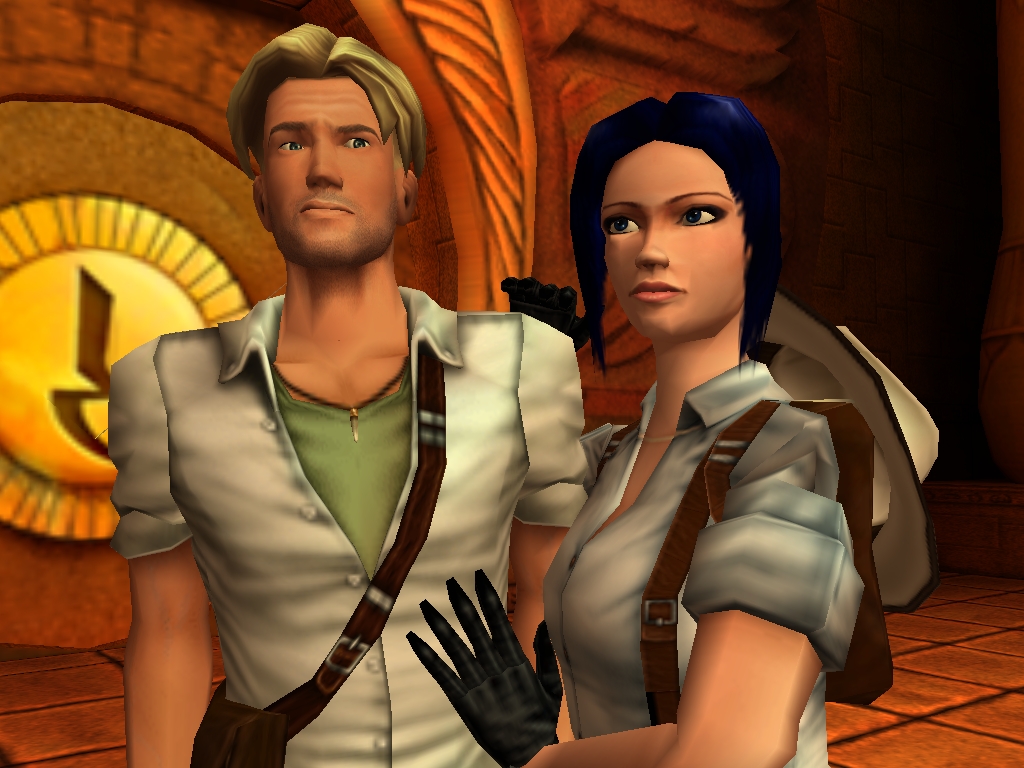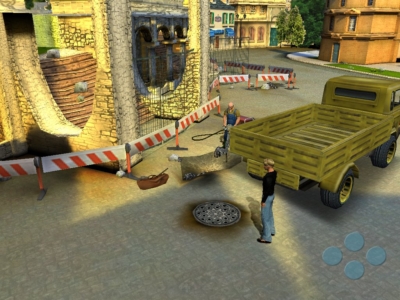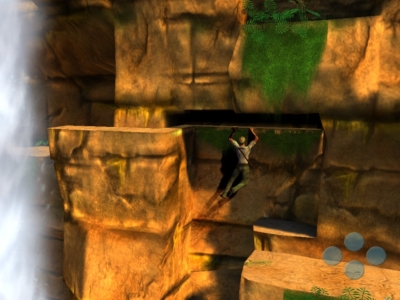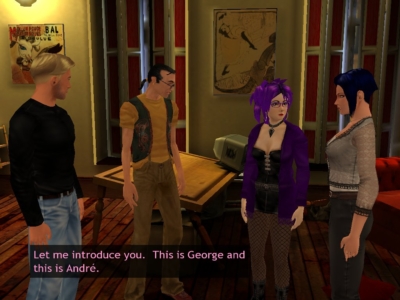
Broken Sword: The Sleeping Dragon
Written by: Rik
Date posted: October 16, 2010
- Genre: Adventure
- Developed by: Revolution
- Published by: THQ
- Year released: 2003
- Our score: 6
Or Broken Sword 3, if you prefer. Yes, friends, George and Nico are back, and this time they’re in 3D – never the easiest of transitions to get right, particularly when adventure-game die-hards lie in wait threatening to pounce on anything that might represent an attempt to water down their beloved genre. Like, you know, trying to turn it into Tomb Raider or something.
If this was something Revolution were worried about, though, they certainly didn’t duck confrontation in the build-up to the game’s release. Previews featured worrisome phrases like ‘action-adventure’ and ‘stealth’, while screenshots showed a buff and stubbly protagonist, dressed like Indiana Jones, leaping from ledges and moving blocks about. What had they done to George? The green jacket was nowhere to be seen.
Personally, I’ve got no problem with a developer changing a few things to move with the times in order to, you know, sell some copies of their game, but while a more action-oriented focus makes sense for the likes of Indiana Jones, successfully turning a plodding bungler like Stobbart into a chiselled gunslinger seems like more of a stretch.

You return to Paris, where the same bloke is still digging the same bit of road as in the first game.
Fortunately, though, despite all appearances to the contrary, that isn’t what Revolution have tried to do here. Sure, George may have been to the gym and lost his razor, but he’s still a lawyer from Idaho, a massive dork, and (perhaps most relevant of all) voiced by the same actor as previous games. Which is a relief, because, frankly, if I’d heard him talking like a gravelly-voiced space marine, I’d have turned the game off before the intro had even finished.
Moreover, Broken Sword 3 is very much still an adventure game. It may not be of the traditional point and click variety, but once you start to use the joypad-driven interface you’ll find that you’re pressing buttons to talk, pick things up or open a door rather than to do a forward roll and shoot some dogs in the face. It’s all quite simply, really – you control your character’s movement using the d-pad, and items that you can interact with are highlighted in the game world, at which point you can use one of the four main buttons to perform an action relevant to that object. It all works pretty well.
At times, there is quite a lot of jumping around to do, but anyone fearing the need for awesome leaping skills can relax as the majority of the work is done for you. Instead of having to time a running jump to perfection, you simply push a button and the game does the rest for you, the emphasis being more on choosing the right place to jump to, rather than executing the jump itself. And the same goes for climbing, hanging off ledges and backing against a wall, all of which you’ll need to do at some stage.
Potential danger, though, does exist at various stages – firstly through the presence of quick-time-events (QTEs), which generally involve pressing a single button within a two-second window at a time of peril to avoid certain death. While there’s been some criticism of this kind of thing in the past, personally I don’t mind it too much as long as it’s not overdone (Fahrenheit!!) and here it’s a good way of involving you in the action without demanding that you navigate a potentially ill-thought-out combat sequence.
Secondly – as alluded to earlier – there are a few stealth sections, which are a bit of the pain in the arse. Mainly, they require you to sneak past one or two extremely inattentive guards, but as with all the worst stealth sequences, you’re never sure what the rules are – and it’s generally a case of trial and error rather than understanding how the system works, but you’re never kept from progressing for too long. There’s one exception to this, though, – a horrible level in which you have to break into your the hideout of your arch-nemesis – it’s huge, there are shedloads of guards everywhere, and you can’t exactly save wherever you like, either.
And while we’re generally being moan-y, we may as well mention that there’s quite a bit of crate-moving to do throughout the game, which – I won’t lie to you – is really fucking annoying, so much so that I’ve had to write about it separately so I don’t derail this whole review with directionless ranting (see Crate Scott!). Oh, and one other thing – it’s fine to fill an FPS with corridors full of doors that you can’t open, but in an adventure, it’s just irritating. It’s not like they’re obviously un-openable doors, either, because they’re all highlighted by the game as something you might be able to open. But most of the time, you can’t – grr.
Still, all things considered, there’s nothing too startling about the change in presentation or setup, and by and large this is a Broken Sword game like any other. The good part of this is obviously that you get another decent mix of globetrotting, corny dialogue and puzzle solving and – as we mentioned – it all fits together pretty well. Unfortunately though, several of the series’ other less favourable hallmarks also seem to have made the transition into this instalment.
Firstly, we’ve got the terrible voice-acting, which seems to be worse than ever. The guy who plays George is fine as usual, but the rest are a less-than-comical selection of shambolic accents and stilted delivery. This would be fine – gently amusing, even – if it were restricted to some of the supporting cast, but unfortunately too many of the main characters’ performances (Nico’s, in particular) are also affected. Issues of stereotyping and crass dialogue also make an unwelcome return, with George taking every opportunity to mock a murder victim because he happened to be a computer nerd (with bad skin, natch) as well as being rude to his recently-bereaved girlfriend on account of her dyed hair and piercings. It’s jarring, not particularly funny, and it just seems unnecessary. And take a look in the mirror, George, you floppy-haired gimp!
Secondly, we have the story, which starts off as something you can vaguely pay attention to before fading into insignificance in the back of your mind at which point the game finishes and you realise you haven’t really been following anything that’s been going on. It all starts off with George (who, as we discussed, has stubble, a bulky physique and is dressed like Indiana Jones) being involved in a plane crash over the Congo and ends with…well, I won’t spoil it for you, but let’s just say that it’s completely ridiculous (and if you want further clues, they’re in the game’s title). In-between times, there’s something about utilising a hidden source of the earth’s energy, which of course has attracted the attention of an extremely EVIL man who looks like a reanimated corpse and his glamorous assistant, a young blonde woman who’s kind of dangerous because she has a tattoo and likes guns. Oh, and along the way, some familiar faces from the previous game pop up, to the extent that some fairly minor characters seem to have been shoehorned in for no reason.
It’s always been the way with Broken Sword: there are memorable sections of play, but nothing about the overarching story ever seems to stick in the memory. I love the presentation of Paris in the first game, but can I tell you anything about the story (only weeks after I played through the game again on the DS)? Frankly, the answer is no (and I’m quite good at that kind of thing normally). This time, I guess there’s no change, except for the fact that the way it’s all presented this time around indicates distinct movie-style aspirations, which makes the lack of a decent story all the more disappointing. On top of that, the pacing seems all wrong, with far too many ponderous sections giving the impression of an overlong game that could have been trimmed a bit.
Broken Sword 3, then: it’s technically accomplished, with a decent interface that ushers in the third dimension pretty successfully, and a good addition to the series. At the same time, flaws from the previous games have been left unresolved, the storytelling leaves something to be desired, and it drags on for at least a couple of hours longer than you might want it to. So, it’s worth a look if you liked the previous two games, then.
Is that a cop-out? [Yes – a reader]





 Posts
Posts